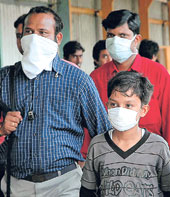 |
| Commuters in Mumbai try to keep swine flu at bay |
How vulnerable is Calcutta to swine flu from the standpoint of climate? The question continues to ring as the flu grips many parts of the country, especially cities like Pune and Mumbai.
Deaths caused by the swine flu virus, H1N1, have now been reported from eight Indian cities. The viral strain was detected in more than 2,400 people. Out of them at least 48 succumbed to the flu with the toll highest in Pune.
Direct correlation between climate change and swine flu is yet to be established, but it can be stated that the virus thrives externally in cool and humid conditions. With the climate changing, the pattern of the viral spread is becoming more uncertain, says Aniruddha Mukherjee, an expert in the state health department. The humid condition is the key, adds Malay Saha of National Institute of Cholera and Enteric Diseases.
But international experts are pointing more directly at climate change. “Swine flu and climate change are inextricably related,” said Angela Mawle, CEO of the UK Public Health Association, recently at a conference in Istanbul.
In October 2008, the Wildlife Conservation Society named the deadly dozen diseases that could spread more intensely as a fallout of climate change. The list includes avian flu, one of the three genetic components of the Mexico swine influenza.
Another epidemiologist, Larry Brilliant, said about two-thirds of the viruses that affect humans are zoonoses — diseases originating from viruses that spread from animals to humans, as happened with swine flu. Brilliant said zoonoses are on the rise because the increasing human population is converting large tracts of animal habitat into human settlements, also increasing man-animal contact and the probability of virus transfer. He predicted in an article in the Wall Street Journal that the world is entering an age of pandemic, when outbreaks of infectious diseases will become more common.
An Intergovernmental Panel on Climate Change report predicted that communicable diseases would rise significantly as a fall-out of changing climate. That brings Calcutta, already known as the “fever capital”, to focus. A CMDA-CMC study found in 2005 that the cases of unknown fever outnumbered all other kinds of diseases in the city. Calcutta has the condition suitable for the spread of H1N1, which is almost like any other influenza virus: the right climate and high population density.
It just needs the virus to settle down in the city population to prosper, said Sudip Banerjee, environmental scientist and former chairman of state pollution control board. He reminded that Calcutta already has a significant number of influenza cases every year. Some call it Calcutta fever.
The swine flu is spreading outside the “normal” flu period in the city and the country, that is, October to May, which hints at a climatic connection, says a Delhi-based expert.










